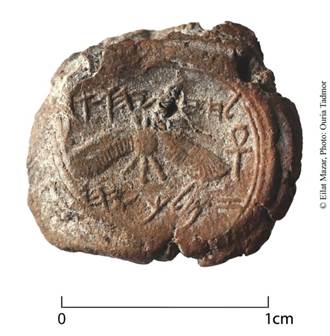News comes this week of the discovery of a bulla (the clay imprint from an inscribed seal), and some are asking whether it belonged to the prophet Isaiah. The bulla was discovered in wet sifting of material taken from an excavation trench in the Ophel area of Jerusalem (just south of the temple mount). A fuller report from The Times of Israel can be found here.

Isaiah Bulla, a 2,700-year-old clay seal impression which potentially belonged to the biblical prophet Isaiah. (Ouria Tadmor/© Eilat Mazar).
The bulla is fragmentary. In the upper register, it seems to have had a pictorial representation of some kind, though it’s hard to make out what it was. It might be something similar to the winged sun disk observable on the seal of King Hezekiah (see picture below), but there is just too much broken off to be sure.
Beneath this there are two lines of writing. The first line contains the letters לישׁעיה (lyšʿyh), which means “Belonging to Isaiah.” The name was almost certainly common in ancient Judah, so this alone does not indicate that the bulla came from the seal of Isaiah the prophet. It’s the second line that is of interest. The second line is incomplete, but the letters נבי (nby) are clearly seen at the beginning of the line. There are two things this could possibly be:
- It might be a name, Nabi or Nabiah (“Yahweh has prospered”) which is not found in biblical texts, but is attested outside the Bible.
- It might be part of the Hebrew word נביא (nbyʾ), which means “prophet.”
So which is it?
Well, first of all, a comment about the letters on the bulla. They represent good Paleo-Hebrew script that conforms with the type seen on other seals/bullae from the 8th–6th centuries BC. We can, for instance, find very similar letters on the bullae of King Hezekiah. The issue with seals and bullae, though, is that because they are so small, one doesn’t expect a huge variation in the form of letters. So a wide timeframe is the best we can do. Isaiah the prophet, though, who lived the late 8th to early 7th century BC, certainly fits into this timeframe.
Second, the bulla was found in a controlled excavation. It would be good to get more details on exactly where it was found. At present, all we know is that it was found in material taken from “an Iron Age layer close to bedrock that was near a foundation trench cut for a wall of a Herodian vault.” How we do we know the layer dates to the Iron Age? And which portion of the Iron Age did it come from?
Finally, is it likely that this is the seal of the prophet Isaiah?
Unfortunately, I don’t think so, though I can’t completely discount the possibility. I have three reasons for this.
- The final letter א (aleph), which would make the Hebrew noun for “prophet,” is not there. Admittedly, the bulla is broken at this point, so we can’t be sure if it was. But we just don’t know if we’re grappling with the noun for prophet, or just a name.
- If the second line refers to a “prophet,” it seems quite unusual that it would be missing the Hebrew definite article, which is just a single letter placed at the front of a word: הנביא (hnbyʾ). There is ample room for it. Although we do have job descriptions in the second line of seals and bullae, these always seem to be definite expressions produced by the grammatical construct state. We see this, for example, on Hezekiah’s seal, where he is named [מלכיהו[דה (mlkyhw[dh])—”the king of Judah.” But there’s nothing to indicate such a grammatical construct state here, which makes the lack of a definite article fairly glaring.
- It’s totally normal to have a patronym (father’s name) on the second line of a seal, even without “son of.” There seems to have been plenty of room to have included the word בן (“son of”) on this line, but it’s quite normal for it to be missing.

Bulla of “Hezekiah, King of Judah,” with pictorial representation of a winged sun disk in the centre.
These three factors lead me to conclude that it’s more likely this is the seal of some called “Isaiah [son of] Nabi” or “Isaiah [son of] Nabiah,” than to be the seal of “Isaiah the prophet.” However, even though the lack of a definite article on the second line is significant, I can’t discount the possibility that it might be referring to a prophet in more stilted terms: “Isaiah. Prophet.” In that case, the status of the biblical prophet, Isaiah son of Amoz, especially in the royal court of Hezekiah, means this might be from his personal seal. And this makes us wonder what document he might have sealed with this bulla?
But, as I said, this is, in my estimation, the less likely interpretation. It’s possible, and certainly plausible that this is Isaiah’s seal. But I don’t think it’s probable. I think it’s the second most likely explanation. I believe in this case we simply have the seal of another, less historically illustrious Isaiah, who was the son of Nabiah.

